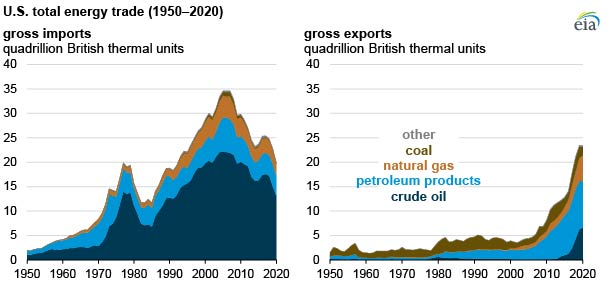
Energy exports from the United States exceeded imports by 3.4 quadrillion British thermal units (quads) in 2020, the largest margin on record, according to EIA’s Monthly Energy Review. U.S. energy exports totaled 23.4 quads, nearly equaling the record high set in 2019, and energy imports fell 13% to 20.0 quads, the lowest level since 1992. The United States exported more energy than it imported for the second consecutive year.
Our Monthly Energy Review reports aggregate totals of energy data in different physical units (barrels, cubic feet, etc.) by converting them into common units of heat, measured in British thermal units. The aggregate heat contents of petroleum, natural gas, and coal vary based on the mix of component products being consumed.

Gross exports of natural gas, which have increased every year since 2014, reached a record high of 14.4 billion cubic feet per day (Bcf/d) in 2020. Gross imports of natural gas fell to 7.0 Bcf/d, the lowest level since 1993.
Both U.S. imports and exports of petroleum products declined in 2020: imports by 15% and exports by 5%. Propane surpassed distillate fuel oil as the country’s most-exported petroleum product.
Trade volumes of coal and other fuels account for relatively small portions of U.S. total energy trade. U.S. coal exports, which had increased in 2017 and 2018, decreased in both 2019 and 2020.











